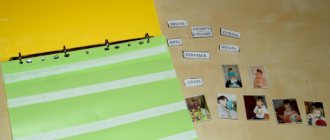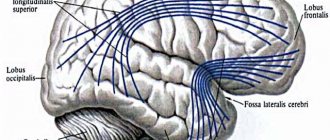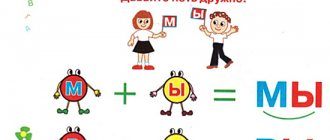The number of children suffering from GSD (general speech underdevelopment) is increasing every year. A similar defect is detected in 70% of babies. It is important to understand that pronunciation defects negatively affect the development of written speech in children of preschool and primary school age. The development of coherent speech in children with special needs development is based on the ability to compose sentences that correspond to their level of development. Linking words in a sentence allows you to express and understand the meaning of what is said. It is the skill of composing lexically and syntactically correct sentences that is the basis of correctional work.
What is ONR
The diagnosis of OHP includes a complex of speech disorders in which the child has not only incorrect articulation, but also problems with comprehending what he hears. To correct the defect, a speech therapist works with preschoolers. Therapy will be more effective the earlier it is started.
A characteristic feature of children diagnosed with general speech underdevelopment is low coherent storytelling skills. The use of speech therapy techniques makes it possible to develop missing skills during the educational and training process in children aged 4–5 years.
Expressive speech disorders in preschool children
Experts call disturbances in the expressive speech of children motor alalia. This is followed by a violation of sound pronunciation, a small vocabulary and the inability to pronounce a phrase that corresponds to the age norm. What is expressiveness?
Setting the sound R
There are 2 types of speech: expressive (pronounced) and impressive (understood). Children with expressive speech disorders have completely preserved intelligence and perception. They perfectly understand all requests from adults and can easily point to the required item. However, a difficult task for them will be to name this very object.
Important! Such disorders are treated by speech therapists and psychologists in specialized preschool institutions. In addition, the baby undergoes a set of physiotherapeutic procedures aimed at launching speech expression, as well as a short course of medications.
Expressive speech disorder in children: what is the prognosis for the future?
With expressive speech disorder in children, experts give a favorable prognosis for the future: more than 50% of children get rid of the problem, and only preschoolers with severe disorders have some consequences in the form of moderate and mild disorders.
As a rule, with intensive classes with a speech therapist, by school age there is no trace of the disorder: the child speaks clearly, clearly, with slight hesitations (within the age norm), his speech is expressive and does not jump from one topic to another.
Expressive speech disorder in a 3-year-old child
The earlier a delay in a child’s speech development is detected, the faster and with less effort it can be corrected. To determine, it is necessary to know at what age certain manifestations of speech utterances are typical for children.
- Humming and babbling appear by 2 and 4 months, respectively. Silence or low activity indicates a disorder.
- Girls develop their first words by 10 months, and boys by 1 year.
- By the age of 2, the baby masters a phrase of 2-3 words.
- By the age of 3, the vocabulary reaches 700 words.
Signs of speech delay in early preschool age are:
- Preference for non-verbal means of communication over speech (use of gestures and facial expressions).
- Impossibility of own speech by 3 years.
- Inability to compose simple phrases of 2-3 words by the age of 2.
Note! Children who have received a diagnosis of “expressive speech disorder” during a medical, psychological and pedagogical examination are sent to a special speech kindergarten for 3 years, with a mandatory annual extension (re-passing the commission).
Rules and procedures for speech therapy work
Coherent speech refers to the ability to compose a common sentence or several interconnected phrases to ensure communication and understanding between people. The formation of coherent speech in children with ODD is the basic task of speech therapy correction. It is inextricably linked with the development of thinking. According to E.I. Tikheyeva, without precise thinking it is impossible to learn the skills of combining statements.
It is in the senior preschool period that the child’s thinking changes - his horizons expand, his thinking process improves, new skills appear, and speech is formed.
But the ability to speak is acquired only during communication. Increasing communication skills contributes to the complication of grammatical forms used by a preschooler. If the child has developed the abilities of primitive spoken language, then the passive vocabulary is close to age requirements. He will be able to talk about his friends, relatives or bright events in life.
Correctional classes for preschoolers diagnosed with speech underdevelopment are aimed at:
- improving phonemic skills;
- correction of incorrect articulation (if any);
- increasing the vocabulary, understanding their lexical meaning;
- developing the ability to construct coherent sentences and their intonation decoration;
- development of skills of independent narration and presentation of what is read or heard.
The speech therapist teaches preschoolers where to start a story, how to make it interesting and emotional, and also how to logically and consistently express their thoughts.
It is with the consistency of presentation that difficulties arise in children with general speech disorders. They do not know how to focus on the main idea, break a story into meaningful parts and arrange them correctly. And the speech therapist’s task is to achieve a logical narrative with interconnected parts that is understandable to outside listeners.
Another problem for preschoolers with OHP is the lack of grammatical skills. They make up short non-union phrases, often repeat the same phrases, and their story does not have a logical conclusion. A defectologist specialist explains to children the cause-and-effect relationship, the characteristics of objects and phenomena, their connection to time and place, and teaches them to generalize words according to specific and generic characteristics.
The mastery of coherent storytelling techniques by a preschooler with ODD is an indicator of the effectiveness of speech therapy correction.
To do this, the defectologist uses various techniques:
- clarifications;
- questions;
- display of pictures;
- analysis of existing speech skills.
At each speech therapy session, the specialist combines several techniques to increase the activity of children’s independent expressions. An integrated approach allows you to vary classes depending on the level of speech development and ability to speak independently, the goals set and the activity of the children.
Formation of detailed utterance skills
To teach a child to compose a coherent story, the speech therapist uses reproductive techniques - describing pictures, composing a story based on a series of images. This causes the greatest difficulties for preschoolers with OHP. It is difficult for such children to have reasoning skills, since such statements require logic and reasoning, and substantiation of their opinion. To learn how to write a reasoning story, a preschooler must understand cause-and-effect relationships.
Forming coherent presentation skills in children with speech underdevelopment is a long process. At the initial stage, the child repeats the task, the rules for its implementation, and the resulting conclusion after the teacher. Then the speech therapist artificially creates situations, stimulating the preschooler to make independent statements. At the same time, the teacher regulates the sequence, argumentation and coherence of the narrative by asking leading questions.
To develop coherent storytelling skills in children with SLD, they are taught to draw up a story plan.
Such preschoolers will need more time to master logical storytelling skills. Joint drawing up of a story plan is used not only as a technique for developing coherent speech, but also as an organization of teamwork. Such activities contribute to the formation of the ability to highlight the main idea and build an independent, consistent story. Subsequently, preschoolers master the skills of composing an independent coherent story with a sequential presentation of events.
Psychological and pedagogical characteristics of children with speech disorders
The psychological and pedagogical characteristics of children are based on Levina’s classification, which identifies 3 forms of OHP:
- Level 1, when there is no statement. In everyday life, only onomatopoeia and various sound complexes are used (a small word that a child uses to designate several objects at once).
- Level 2, common speech begins. A preschooler can already pronounce short phrases and participate in dialogues (the answers are usually monosyllabic). Children's monologues contain many errors of both sound and semantic nature.
- Level 3, residual speech underdevelopment. The child actively uses both dialogic and monologue forms. There are still hesitations in the agreement of adjectives and nouns, errors in inflection and word formation of unfamiliar words.
Features of speech of children with mental retardation
Preschoolers with mental retardation (MDD) often use a large number of words without understanding their meaning. Due to grammatical immaturity, many mistakes are made both in the design of sentences and in isolated words. A feature of the speech development of children with mental retardation is defects in pronunciation and sound analysis and synthesis (the child cannot complete a task where it is required to select and indicate a specific sound).
Features of children with mental retardation
Characteristics of a child with speech impairment
Children with speech impairments have the following characteristics:
- emotionally unstable and subject to sudden mood swings;
- has sluggish and passive organs of articulation;
- attention and memory are reduced, the thought process is inhibited;
- hyperactive or, conversely, passive and quickly gets tired during the learning process;
- if he is in a regular kindergarten group (not a speech group), he may be an outcast among his peers.
Setting the sound "Ch"
Retelling in speech development
At the age when it’s time to move to the preparatory group, many children with ODD cope well with exercises in retelling small interesting passages; they easily come up with their own stories based on plot pictures.
This proves that they are capable of producing coherent speech. However, it is worth comparing the results of their speech activity with the same results of their peers, and it becomes clear that the degree of development of speech abilities in these children is significantly below the norm.
Formation of coherent speech
Despite the large difference between the development of speech in healthy children and the development of speech in children suffering from ODD, the process of developing coherent speech itself has common features.
No matter what speech pathology the child has, while maintaining a healthy intellect, speech formation goes through three main stages, which A.N. lists in his works. Gvozdev.
In previous articles, we looked at three levels of speech development (the fourth level considered is not recognized by all researchers). So these three levels can be compared with the stages proposed by Gvozdev.
Levels of speech development according to Gvozdev
Level one, which speech therapists associate with the child’s lack of speech means accepted by people, is compared with the first stage, which, according to Gvozdev, is characterized by an abundance of one-word sentences. Also during this period there are sentences that have two root words.
Level two, which speech therapists associate with the beginning of the development of phrasal speech, is compared with the second stage, which Gvozdev associates with the beginning of mastering the grammatical structure of speech.
Level three, which speech therapists associate with developed everyday phrasal speech, which has problems of a lexical, grammatical and phonetic nature, is compared with the third stage, which Gvozdev associates with the period when the child begins to assimilate the morphological essence of the language.
Properties of developed speech
Well-formed coherent speech is characterized by the following properties: it is detailed, logical, and the child produces it arbitrarily without long delays for thinking.
And vice versa, underdevelopment of coherent speech is manifested in the fact that the child is not able to establish cause-and-effect relationships between two or more events, he perceives reality too narrowly, he lacks the acquired speech means in order to express his point of view, it is very difficult to assimilate monologue speech.
According to R.E. Levina’s speech of preschoolers with ODD is quite extensive. However, it is noticeable that they do not use some lexical meanings quite accurately.







